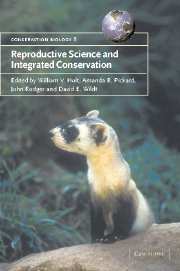Book contents
- Frontmatter
- Contents
- List of contributors
- Foreword
- Part I Introduction
- Part II Reproduction and population viability
- Part III Reproductive techniques for conservation management
- Part IV Integrated conservation management
- 14 Integrating reproductive sciences into recovery programmes for declining and extinct marsupial populations
- 15 Captive breeding and predator control: a successful strategy for conservation in Western Australia
- 16 Black-footed ferret: model for assisted reproductive technologies contributing to in situ conservation
- 17 Genetic resource banks for species conservation
- 18 Fertility control for wildlife
- 19 Contraceptive vaccine development
- 20 Field applications of fertility control for wildlife management
- Part V Reproduction science in non-mammalian species
- Part VI Conclusions
- Index
- References
14 - Integrating reproductive sciences into recovery programmes for declining and extinct marsupial populations
Published online by Cambridge University Press: 21 January 2010
- Frontmatter
- Contents
- List of contributors
- Foreword
- Part I Introduction
- Part II Reproduction and population viability
- Part III Reproductive techniques for conservation management
- Part IV Integrated conservation management
- 14 Integrating reproductive sciences into recovery programmes for declining and extinct marsupial populations
- 15 Captive breeding and predator control: a successful strategy for conservation in Western Australia
- 16 Black-footed ferret: model for assisted reproductive technologies contributing to in situ conservation
- 17 Genetic resource banks for species conservation
- 18 Fertility control for wildlife
- 19 Contraceptive vaccine development
- 20 Field applications of fertility control for wildlife management
- Part V Reproduction science in non-mammalian species
- Part VI Conclusions
- Index
- References
Summary
INTRODUCTION AND OBJECTIVES
Marsupial evolution, diversity and extinction
Australia's marsupials appear to have evolved through colonisation by progenitor species from South America (Szalay, 1982; Temple-Smith, 1987; Rich, 1991). Land bridges connecting Australia, Antarctica and South America (c. 45 million years ago) enabled the filtered passage of species from South America across the Antarctic landmass to Australia. Subsequent evolution and radiation produced a distinct marsupial fauna that adapted to changing landscapes and habitats. Various palaeontological studies (Archer et al., 1989; Murray, 1991; Rich, 1991) have described an amazing diversity of marsupials, including a rhinoceros-sized diprotodontid, a large carnivorous marsupial ‘lion’ (Thylacoleo; distantly resembling a sabre-toothed cat), a tapir-like marsupial (Palorchestes sp.), various thylacine species, rainforest-based marsupial moles and gigantic wombats (Phascolonus and Ramsayia), wallabies (Protemnodon), kangaroos (Macropus titan) and a Tasmanian devil (Sarcophilis laniarius), all of which became extinct.
Arrival of humans on the Australian continent started a process of extinctions that was accelerated by the entry of Europeans into the fragile landscape. Habitat destruction, increased hunting and modern weapons combined with introductions of the fox, dog, rabbit, goat and cat caused a rapid loss of species, especially marsupials in the <8 kg weight range. By the mid-twentieth century, nine marsupial species had been exterminated. The 2000 IUCN Red List of Threatened Species records five Australian marsupials as ‘Critically Endangered’, 17 as ‘Endangered’ and 22 as ‘Vulnerable’.
- Type
- Chapter
- Information
- Reproductive Science and Integrated Conservation , pp. 211 - 231Publisher: Cambridge University PressPrint publication year: 2002



